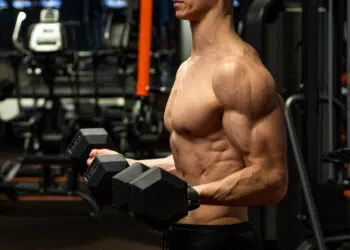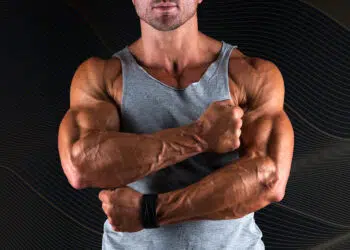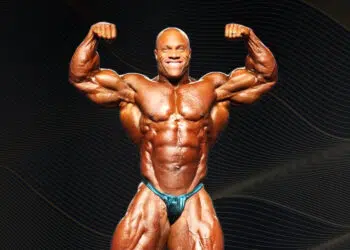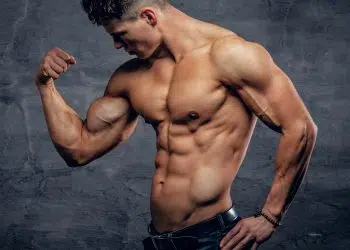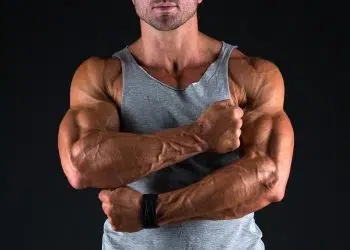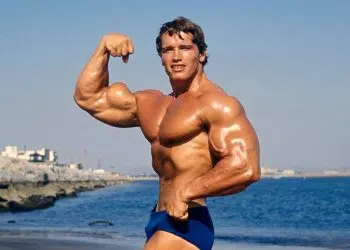Let’s be honest for a moment – there isn’t a bodybuilder alive who doesn’t want bigger, more muscular arms. Exercisers dedicate entire workouts to building more massive biceps and triceps. That’s a lot of training time and volume for what is actually a relatively small muscle group.
Monday might be World Chest Training Day, but Arm Day is arguably the most popular (and enjoyable) workout of the week. After all, who doesn’t enjoy getting a great arm pump and feeling their biceps and triceps fill their sleeves?
When it comes to biceps training, curls are the way to go, and there are plenty of variations to choose from. Most involve using a barbell or dumbbells, and cable curls are pretty popular, too.
However, you can have too much of a good thing, and doing the same old curls over and over again could mean your workouts aren’t as productive as they could be.
So, breathe new life into your biceps workouts with plate curls. This old-school arm exercise is a great way to bust through training plateaus and can help you build the biceps of your dreams.
In this article, we reveal why and how to do plate curls and the nine best variations and alternatives.
Level Up Your Fitness: Join our 💪 strong community in Fitness Volt Newsletter. Get daily inspiration, expert-backed workouts, nutrition tips, the latest in strength sports, and the support you need to reach your goals. Subscribe for free!
Plate Curls – Muscles Worked
Plate curls are an isolation exercise. That means they only involve movement at one joint. However, despite this, they still manage to use several upper and lower arm muscles. The main muscles developed during plate curls are:
Biceps brachii – known as the biceps for short, this is arguably the most well-known muscle in the human body. Located on the front of your upper arm, the biceps flex your elbow and shoulder joint and are also responsible for the supination of the forearm.
Biceps brachii means two-headed arm muscle, referring to the biceps having two separate origin sites and a single insertion. Of these two heads (long and short head), plate curls emphasize the long head, which is located on the outside of the biceps.
Brachialis – the brachialis lies beneath the biceps, so it’s almost entirely out of sight. However, it still contributes a lot to your upper arm size and strength and helps “push up” your biceps to make it appear larger. The brachialis is responsible for flexion of the elbow joint.
Brachioradialis – located mainly in the lower arm, the brachioradialis is a forearm muscle that also flexes the elbow joint. It’s also involved in the supination of the forearm. Well-developed brachioradialis muscles will give you thicker, more muscular forearms.
How to Do Plate Curls
Get more from plate curls while keeping your risk of injury to a minimum by following these guidelines:
- Stand with your feet shoulder-width apart. Bend your knees slightly for balance, pull your shoulders down and back, and brace your core. Hold a weight plate, so your hands are directly opposite one another, i.e., the “quarter to three” position.
- With your upper arms tucked in close to your sides, bend your arms and curl the weight plate up to your chest. Resist the temptation to use your legs or back to help you swing the weight up.
- Lower the weight plate back down, making sure you control the descent, until your arms are straight, and continue for the desired number of reps.
Plate Curl Benefits
Not sure if plate curls deserve a place in your next arm workout? Consider these benefits and then decide!
Low-tech but high effect – arm exercises don’t come much more straightforward than plate curls. After all, the only thing you need to do this exercise is a standard weight plate. As such, they’re ideal for anyone who trains in a basic gym, who doesn’t have access to dumbbells, or who prefers a low-tech workout.
Train multiple arm muscles simultaneously – it’s not enough to train your biceps if you want bigger, more muscular arms. You also need to pay attention to your brachialis and brachioradialis muscles. Plate curls hit all these muscles at the same time, providing a time-efficient arm workout.
Increase your grip strength – plate curls require and develop a strong grip. Holding a weight plate is more challenging than gripping a barbell or dumbbells. As such, doing plate curls are better for building your grip than most other biceps exercises.
Ideal for drop sets – being able to move quickly from one weight to the next means that plate curls are ideal for drop sets. Line up a 20kg, 15kg, and 10kg plate and then do a back-to-back set of plate curls with each weight that will leave your biceps pumped and burning.
A useful arm training variation – doing the same old barbell and dumbbell curlscan soon become boring, and boring workouts are less effective. Adding plate curls to your arm workout could be the variation you need to bust out of your current training rut and get back on the gains train!
Plate Curl Drawbacks
While plate curls are a mostly beneficial exercise, there are also a few drawbacks to consider:
Larger weight increases – most dumbbell sets go up in increments of 2.5kg/5lbs. Weight plates tend to go up in larger steps, typically 5kg/10lbs. This means that you may have to increase your training weights by more than is comfortable.
Reduced range of motion – using a large weight plate (20kg/45lbs) may mean that you cannot fully extend your arms at the bottom of each rep of plate curls. This could cause adaptive shortening unless you also do exercises that involve a full range of motion, e.g., preacher curls or incline dumbbell curls.
Level Up Your Fitness: Join our 💪 strong community in Fitness Volt Newsletter. Get daily inspiration, expert-backed workouts, nutrition tips, the latest in strength sports, and the support you need to reach your goals. Subscribe for free!
Limited overload – the heaviest weight plates in most gyms are 45lbs/20kg. Some have 55lbs/25kg plates. Regardless, if you are very strong, you may find that plate curls are not challenging enough as you won’t be able to use more than the weight of the heaviest plates in your gym.
9 Plate Curl Variations and Alternatives
Plate curls are an excellent biceps exercise, but that doesn’t mean you need to do them all the time. Here are nine variations and alternatives that you can use to keep your workouts productive and interesting:
1. Reverse plate curls
Plate curls are already a pretty effective forearm exercise. But, doing them with your hands pronated (palms down) makes them even more forearm-centric. Your biceps are still involved but to a lesser degree. This variation really targets your lower arms.
How to do it:
- Stand with your feet shoulder-width apart. Bend your knees slightly for balance, pull your shoulders down and back, and brace your core. Hold a weight plate, so your hands are near the top and in a “five to one” position.
- With your upper arms tucked in close to your sides, bend your arms and curl the weight plate up to your chest. Resist the temptation to use your legs or back to help you swing the weight up. Keep your wrists straight throughout.
- Lower the weight plate back down, making sure you control the descent, until your arms are straight. Continue for the prescribed number of reps.
2. Reverse barbell curls
Reverse barbell curls work the same muscles as reverse plate curls, i.e., the brachioradialis, brachialis, and biceps. It’s also a good exercise for general forearm size and strength. Use a thick bar to make this exercise even more challenging.
How to do it:
- Hold a barbell with an overhand, shoulder-width grip. Pull your shoulders down and back and brace your abs. You can use a thumbs around or thumbless grip as preferred, although the thumbless grip is considerably more demanding.
- Keeping your upper arms close to your sides, bend your elbows and curl the bar up to your chest.
- Slowly extend your arms and repeat.
- You can also do this exercise using an EZ barbell if preferred.
3. Waiter curls
The waiter’s curl is another low-tech but high effect biceps exercise. All you need for this one is a single dumbbell. The waiter’s curl is a pure biceps exercise as it all but eliminates your forearms from the movement. Done with a fully supinated or palms up grip, this exercise is thought to increase your biceps peak by emphasizing the long head of the biceps muscle.
How to do it:
- Hold a single dumbbell with your palms upturned and your hands inside the lowermost plate. Do not grip the dumbbell with your fingers. Instead, keep your hands open. Tuck your upper arms into your sides, brace your core, and pull your shoulders down and back. Straighten your arms as far as possible without letting the dumbbell slip from your hands.
- Without using your legs or back for assistance, curl the dumbbell up to your chest and then lower it again. You won’t be able to fully extend your arms, but that’s okay – just use the largest range of motion you can.
- Continue for the required number of reps.
4. Dumbbell hammer curls
If you look closely, you’ll see that plate curls are very similar to dumbbell hammer curls. In fact, they use the same basic movement and work the exact same muscles. However, using dumbbells may mean you can use a larger range of motion and they make it easier to fine-tune your training weights.
How to do it:
- Hold a dumbbell in each hand with your arms by your sides and palms facing your legs. Tuck your upper arms into your ribs, pull your shoulders down and back, and brace your core.
- Without using your legs or back for assistance, bend your elbows and curl the weights up toward your shoulders. Do NOT rotate your wrists. Instead, make sure your palms face inward, i.e., a neutral position.
- Extend your arms, lower the weights back down to your sides, and repeat.
- You can curl both dumbbells up at once or, if you prefer, use an alternating arm action for this exercise.
5. Cable hammer curls
While there is nothing wrong with dumbbell hammer curls, cable curls may be better for some exercisers because they keep the target muscles under almost constant tension. Use a rope handle for this popular upper and lower arm exercise.
How to do it:
- Attach a rope handle to a low cable machine. Hold one end in each hand with your thumbs pressed up against the stoppers/knots at the end or the rope.
- Stand with your feet about shoulder-width apart, arms tucked into your sides, and core braced.
- Without rotating your wrists, bend your arms and curl the handles up to your shoulders.
- Extend your arms and repeat.
6. Neutral grip chin-up
Neutral grip chin-ups might not look much like plate curls. Still, if you take a moment to analyze the arm action in both these exercises, you’ll soon see that they are actually very similar.
The main difference is that, with NG chin-ups, you’re curling your shoulders up to the bar instead of curling the bar up to your shoulders. This exercise is ideal for anyone who wants to train their arms and lats at the same time or needs more weight to overload their biceps, brachialis, and brachioradialis muscles.
How to do it:
- Grip the neutral/parallel handles, so your palms face inward. Hang with your arms straight and feet clear of the floor. Pull your shoulders down and back and brace your abs.
- Without kicking or swinging, bend your arms and pull yourself up until your chin is above your hands. Keep your elbows down, back, and tucked into your sides.
- Slowly extend your arms and repeat.
- Make this exercise more demanding by wearing a weighted vest or using a chin/dipping belt.
7. Hammer concentration curls
According to studies by the American Council on Exercise (ACE), concentration curls are one of the best biceps exercises you can do. Keeping your hands in a neutral position emphasizes the brachialis and brachioradialis muscles, making hammer concentration curls an excellent alternative to plate curls.
How to do it:
- Sit on an exercise bench with a dumbbell in one hand. Lean forward, place your triceps against your leg, and let your arm hang straight down from your shoulder. Rotate your wrist so that your thumb is pointing forward.
- Without turning your wrists, bend your elbow and curl the weight up to your shoulder.
- Extend your arm and repeat.
8. Pinch grip plate curls
Pinch grip plate curls work your biceps, forearms, and fingers, making it a very functional exercise. It’s a good movement for anyone who needs a firmer grip, such as climbers, wrestlers, or football players. You can do this exercise with a single plate, but it’s even more effective if you use two plates squeezed together.
How to do it:
- Hold your weight plate(s) between your fingers and thumb. Squeeze as hard as you can to get a good grip.
- Starting with your arm straight and the weight down by your side, bend your elbow and curl the weight plate up to your shoulder.
- Extend your arm and repeat.
- Do the same number of reps on the opposite side.
8. Zottman curl
The Zottman curls an old-school exercise that combines hammer curls with reverse curls and regular biceps curls to create a very effective upper and lower arm builder. While this one does require a bit of extra coordination, if you’ve only got time to do one arm exercise, Zottman curls would be an excellent choice. You can do this exercise seated or standing as preferred.
How to do it:
- Stand with your feet shoulder-width apart, and knees slightly bent for balance. Hold a dumbbell in each hand by your sides, palms facing your legs. Make sure your torso is fully upright. Brace your abs.
- While keeping your upper arms close to your sides, bend your elbows and curl the weights up to your shoulders. As you raise the weights, rotate your wrists so that your palms are turned upward. Curl the weights all the way up until your biceps are fully contracted.
- Next, without lowering the weights, rotate your forearms so your palms are now facing downward. This is called a pronated grip.
- Extend your arms and, keeping your hands pronated, lower the weights down towards the starting position. Repeat for the prescribed number of repetitions.
9. Cross-body hammer curls
Regular hammer curls involve lifting the weight straight up. With cross-body hammer curls, you take the weight across your body, increasing brachialis and brachioradialis engagement. This is another excellent alternative to plate curls for when you want to really focus on your brachialis muscles.
How to do it:
- Hold a dumbbell in each hand with your arms by your sides and palms facing your legs. Tuck your upper arms into your ribs, pull your shoulders down and back, and brace your core.
- Without using your legs or back for assistance, bend your elbows and curl one weight up and across toward the opposite shoulder. Do NOT rotate your wrists. Instead, make sure your palms face inward, i.e., a neutral position.
- Extend your arm, lower the weight back down, and then do your next rep on the opposite side.
- Continue alternating arms for the duration of your set.
Plate Curls – Wrapping Up
Plate curls might be old-school, but when it comes to building bigger, stronger muscles, the old-school is usually hard to beat. Sometimes, the best way to shock your muscles into growth is to hammer them with simple, basic exercises. Hard work conquers all!
That doesn’t mean you need to give up barbell, dumbbell, or cable curls. After all, these exercises work perfectly well. But, if your arm development has stalled, you can get things moving again by adding some new and unusual exercises to your workouts.
Plate curls might be simple, but don’t let that dissuade you from doing them. Instead, they could be your new secret weapon for building stronger, more muscular arms.
Interested in measuring your progress? Check out our strength standards for Bench Press, Barbell Curl, Incline Dumbbell Curl, and more.


